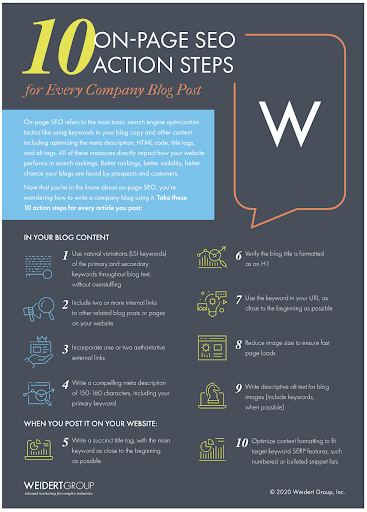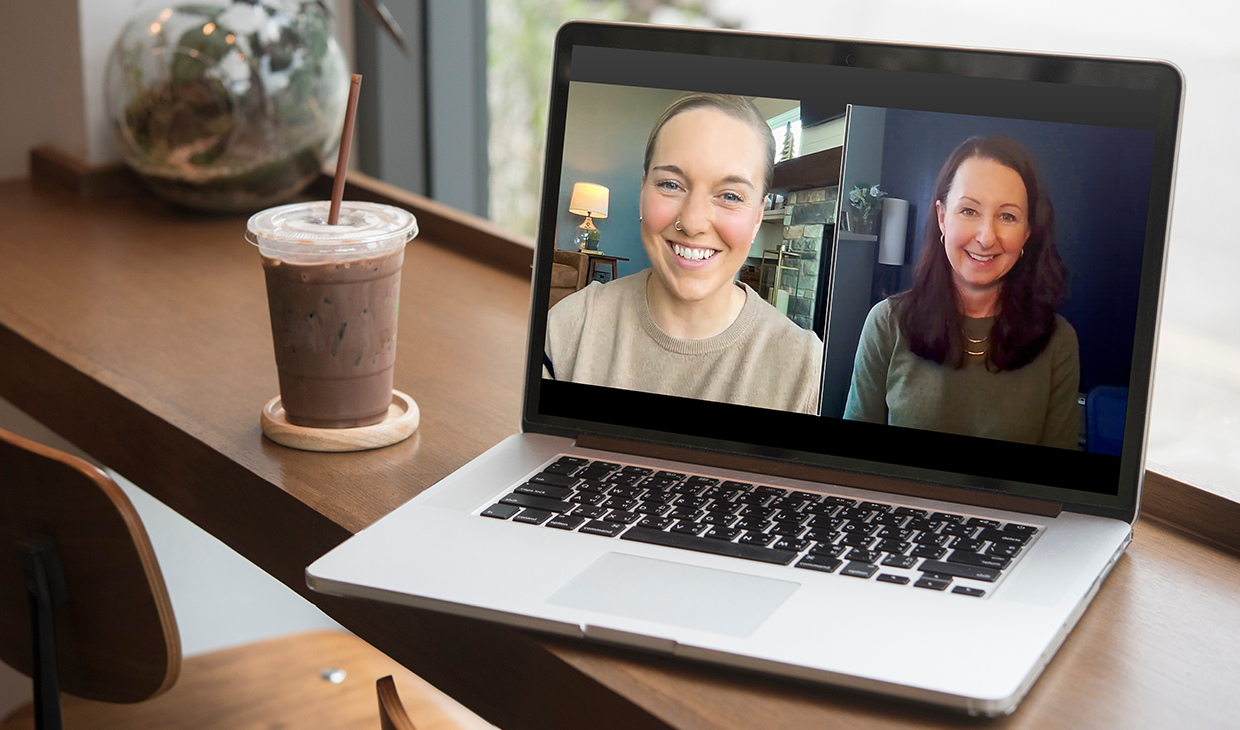The Ultimate List of No-Fail B2B Blogging Best Practices
Written by

The English language is hard. Writing is even harder. Maybe that’s why so many companies outsource their content marketing to an agency.
Knowing how to write a company blog post requires more than making sure everything is spelled correctly and that you’ve used proper grammar. Don’t get me wrong; those things are really important, but B2B blogging best practices involve so much more. Be diligent in adhering to the process, and you’ll soon master how to write a great B2B blog that’s optimized for humans and search engines while also helping to solve a problem.
Corporate blogs today need to not only keep a reader’s attention, they first need to attract attention by getting found in search engines. That takes as much strategy as it does creativity — especially in complex industries like manufacturing and distribution.
Use these company blog best practices to help maximize your writing efforts for both SEO and your preferred prospects/customers.
How to Write a B2B Blog Post
- Determine Keywords
- Craft a Headline
- Write an Introduction
- Include Subheads
- Focus on the Main Message
- Be Consistent
- Optimize On-Page SEO Elements
- Include a Brief Conclusion
- Add a CTA
- Don’t Forget the Meta Description
- Write Social Media Lead-Ins
P.S. Don’t miss the on-page SEO infographic below, too! Print it and keep it at your desk for every blog you publish.
1. Determine Keywords
So, you’ve decided on a blog topic, but don’t go into a writing frenzy just yet. First, determine which keywords your target audience is most likely to enter into search engines. Naturally incorporate these target keywords into your copy so they don’t sound forced.
Use SEO tools to research primary and secondary keywords, and prioritize them based on a topic cluster strategy. Some helpful online tools we use for keyword research include:
- AnswerThePublic
- Ubersuggest
- SEMrush
- HubSpot’s SEO Tool (requires a HubSpot account)
2. Craft a Headline
Have you ever clicked on a headline expecting one thing and the content turned out to be a big disappointment? Click bait headlines are annoying, waste time, and make a poor impression.
A bad or irrelevant headline can make or break your engagement and will lead to higher bounce rates, affecting your search engine results page (SERP) ranking. Write a blog post headline that clearly communicates what readers will learn.
- Keep headlines under 70 characters
- Avoid sensational language
- Include target keywords
- Use the primary keyword early in your headline
- Keep the primary keyword intact (avoid rearranging words)
- Take advantage of modifiers (“2020,” “Best,” “Guide,” etc.)
- Use this free tool to test headline variations until you score at least 70
3. Write an Introduction
First impressions matter. The way you introduce readers to your topic needs to pique their interest and convince them that reading your blog article is worth their time.
- Set the stage for your readers by giving them a snapshot of what they’ll learn
- Consider sharing a compelling statistic or insight that demonstrates the importance of the topic you’ll cover
- Keep your introduction succinct and try to limit it to 2 or 3 short paragraphs, not one long block of text
- Use the primary keyword within the first 100 words
- Don’t be afraid to incorporate some personality into your text by sharing an anecdote or clever metaphor to show that your article will be both educational and engaging
4. Include Subheads
Each subhead of your article should form the basic outline, giving readers (and search engines) a quick glimpse of the points you’ll make. Subheads help break up long blocks of text, making it easier to read and digest.
- Use the primary target keyword in the first or second H2 subhead
- Use secondary keywords (when possible) in the other H2 subheads
RELATED: Quick Marketing Wins 101 — On-page SEO
5. Focus on the Main Message
The main “meat” of your blog article is, of course, the overall content you create within those subheadings. This is where your research, subject matter expert (SME) interviews, and industry knowledge can shine. There are still some basic company blog best practices to consider when sharing all that wisdom, however:
- Use natural variations of the primary and secondary keywords throughout, but avoid overstuffing them in your copy. If you find yourself using a keyword repeatedly, look for alternative phrases (e.g., ERP system, ERP solution, ERP platform, and ERP software are all different ways to identify Enterprise Resource Planning)
- Include two or more internal links to other related blog posts on your website
- Include one or two authoritative external links
- Use statistics that show data within the last two years (Caution: many websites still publish data that is woefully outdated. Track down the original source.)
- Cite authoritative sources for statistics (with a hyperlink or footnote); B2B companies should avoid referencing sites like BuzzFeed, Huffington Post, etc.
- The goal of a blog is to be helpful. Avoid talking about yourself or your products too much, or it could come across as just another sales pitch
6. Be Consistent
Maintain a consistent tone and style between all your blog posts even if you have different writers creating your content. You may have one writer who likes to use complex industry jargon while others may use more casual language. Help them express their expertise and personality while still maintaining consistency with your brand. Your editing skills may need to come into play to achieve this goal.
- Review other blogs and content on your website. Is there a certain tone, style, or “personality” to the writing? Remain consistent to your established brand
- Note industry terms used in your content and stay consistent (e.g., cybersecurity vs. cyber security)
- Avoid overuse of acronyms and industry insider language. Your prospects may not be familiar with words you commonly use. At a minimum, spell out the term the first time and include the acronym in parentheses; then use the acronym in the rest of your article. Some examples include:
- Multifunction printer (MFP)
- Enterprise resource planning (ERP)
- Enterprise content management (ECM)
- Growth-driven design (GDD)
- Search engine optimization (SEO)
- Internet service provider (ISP)
- Bill of materials (BOM)
- Engineering change order (ECO)
- Design for manufacturability (DfM)
7. Optimize On-Page SEO Elements
Writing a great B2B blog — or any blog — needs to take on-page SEO into consideration.
On-page SEO refers to the most basic search engine optimization tactics like using keywords in your blog copy and other content including optimizing the meta description, HTML code, title tags, and alt tags. All of these measures directly impact how your website performs in search rankings. Better rankings and better visibility means a better chance your blogs are found by prospects and customers.
- Write a succinct title tag, with the main keyword as close to the beginning as possible
- Verify the blog title is formatted as an H1
- Use the keyword in your URL, as close to the beginning as possible
- Reduce image size to ensure fast page loads
- Write descriptive alt text for blog images (include keywords, when possible)
- Optimize content formatting to fit target keyword SERP features, such as numbered or bulleted snippet lists
- Use natural variations (LSI keywords) of the primary and secondary keywords throughout blog text, without overstuffing
- Include two or more internal links to other related blog posts or pages on your website
- Incorporate one or two authoritative external links
- Write a compelling meta description of 150-160 characters, including your primary keyword
Making the most of SEO quick wins when you’re first learning how to write a company blog post takes a little practice. This infographic serves as a handy reference until it’s second nature to you.
Infographic: SEO Tips for B2B Blog Posts

8. Include a Brief Conclusion
Once you’re done making all your points, it’s time to wrap things up. Include a paragraph or two to bring some closure and help the reader take the next step.
- Provide a brief recap restating the value of the information shared
- Invite readers to learn more by encouraging them to download a relevant content offer
- When appropriate, encourage readers to get in touch by providing a link to your contact page
- In conclusion, try to avoid saying “in conclusion” in your copy or subheads. (See what I did there?) But seriously, find more creative ways to sum up your blog post so it remains conversational and inviting rather than sounding like the end of a college thesis paper
9. Add a CTA
A major goal of an inbound marketing strategy is lead generation. To capture qualified leads, include a call-to-action (CTA) for a content offer that goes more in-depth in exchange for a prospect’s contact information.
- Choose a content offer that has a natural tie-in to the blog topic
- Make sure you use a visually appealing CTA that will capture attention
- Where appropriate, include an inline CTA in the first half of your blog post to help capture more leads
10. Don’t Forget the Meta Description
In addition to your blog title, the meta description is what viewers will see first in search engines. It serves as a brief summary of the value that readers can expect when they click through to your article.
- Limit your meta description to 150-160 characters; anything longer will be truncated
- Summarize the content and value of your article to get users to click on it in SERP
- Include primary keywords and language that intrigues people to click through
Examples:
Which snack bars rate at the top for flavor and nutrition? See Consumer Reports findings and trends, clean label statistics, and formulation tips.
Fix printer problems yourself! DIY tips for how to fix paper jams, black streaks, scanning issues, mobile printing, slow printers, network issues, and more.
11. Write Social Media Lead-ins
Once you’ve completed your blog post, write out a few suggested social media lead-ins for your company’s page and for employees who like to share your content. Try to make your social lead-ins personable and inviting. While not technically part of your article, they’ll help increase traffic and get more people to read your post.
- LinkedIn: Ideal length is 75-100 characters, but 140 is the max before it’s truncated
- Facebook: Ideal length is 100-250 characters
- Twitter: Ideal length is 100-140 characters. Include hashtags when appropriate
More Helpful Blog Writing Resources
We’ve written extensively on how to create great content on our own blog, so check out these other helpful articles to learn more:
- Tips for Optimizing Your Blog to Improve SEO and Organic Reach
- Creating Content: 9 Questions To Ask Before Writing Your Blog
- How to Create a Keyword List
- 20 Most Commonly Misused Words in Content Marketing
- 5 Reasons Outsourced Content Marketing Makes Sense
We’ve also got a much more extensive B2B Business Builders Blogging Guide you can check out. Be sure to download it to learn more.
When all is said and done, it’s good to realize that some people are born with a “writing” gene, while some more easily acquire other technical skills. It’s okay to admit you’re not a born writer. Remember that, while there certainly are ways to improve, it may be best to focus your efforts and time on what you do best. Leave the writing to those who have a track record in your industry and know how to write compelling content.
If that sounds like an intriguing idea, feel free to reach out to us to talk through how our agency can help bring your inbound marketing efforts to a new level and get results and ROI that far exceed any investment you might make.
Subscribe To Our Blog
Information. Insights. Ideas. Get notified every time a new Weidert Group blog article is published – subscribe now!
You May Also Like...

Search Engine Optimization
How Falcon Rebuilt Industrial AI Search Visibility in 2025

Search Engine Optimization
The New Search Visibility Checklist for AI-Era Content Marketing

Search Engine Optimization
SEO Isn’t Dead. It’s Evolving: How B2Bs Can Stay Visible in the Age of AI
Accelerate Your Growth with
Weidert Group
If you’re ready to explore a partnership, request a personalized consultation with our team.

